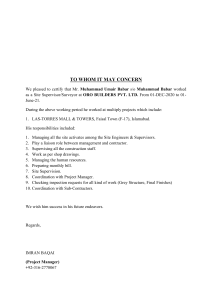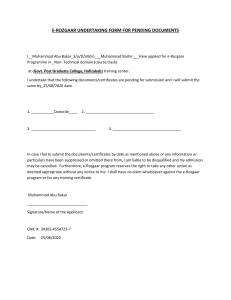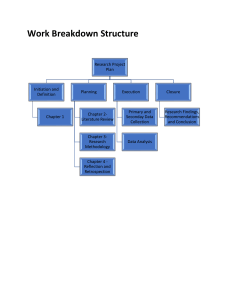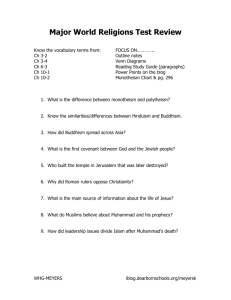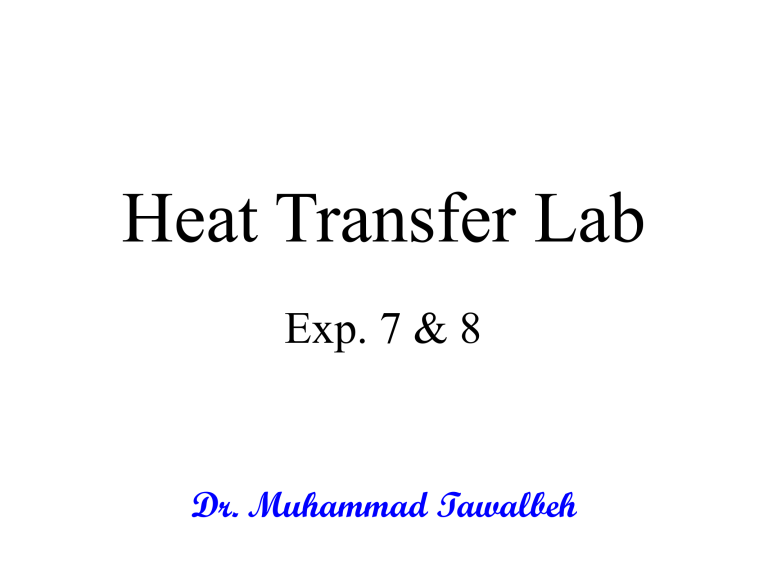
Heat Transfer Lab Exp. 7 & 8 Dr. Muhammad Tawalbeh Exp. 7 & 8 1- EXP # 7: Free & Forced Convection (External flow). 2- EXP # 8: Forced Convection Heat Transfer (Internal flow). Experiment 7 Objectives: Part A: To compare the maximum temperature of each surface reached for a given input power under free convection. Part B: To compare the surface temperatures of the heat transfer surfaces for a fixed input power under forced convection. Dr. Muhammad Tawalbeh 3 Theory Forced Convection: This is when an external device moves the fluid around or across an object. The motion of the fluid moves the heated fluid away from the surface of the object. The higher the fluid velocity, the faster it moves the heat away from the object. Free Convection: This is when the heat transfers from the object because of the fluid (air) motion due to density difference (Buoyancy force). Dr. Muhammad Tawalbeh 4 Theory Comparison of Airflow and Pressure Drop: - The flat surface has insignificant effect on the airflow and the main body of the airflow does not pass through the surface. - The pinned surface sits directly in the main body of airflow. The airflow at the inlet is usually uniform, however, the flow after the pins becomes turbulent and this causes a variation of velocity around the pins. This also creates a pressure difference between upstream and downstream flows (pressure drop). - The finned (plate) surface sits directly in the main body of the flow. It has a less noticeable effect on the flow and pressure drop than the pinned surface, with a relatively uniform flow before and after the fins. Dr. Muhammad Tawalbeh 5 Theory Thermal lag: - Considering the heat conduction through a solid conductor, the heat takes time to move from one part to another depending on the thermal properties and dimensions of the solid conductor (thermal conductance or resistance). - Assuming no losses, the heat then spreads through the conductor until the whole conductor reaches a thermal equilibrium (same temperature). - The time taken for the heat energy to move from T1 to T2 is called the thermal lag. Dr. Muhammad Tawalbeh 6 Theory Thermal Gradient In reality, there will be losses due to radiation and convection which affect the amount of heat that transferred to furthest parts; therefore, the temperature of the furthest points may never reach the same temperature as the part near the heat source. The conductor then has a thermal gradient along its length. Plate Fin Pin Fin Dr. Muhammad Tawalbeh 7 Apparatus Three aluminum surfaces will be used: 1- Flat (No Fins) 2- Finned (Plate Fins) 3- Pinned (Pin Fins) Dr. Muhammad Tawalbeh 8 Data Manipulation GRAPH PLOT : Plot two separate bar graphs between the temperature difference (y-axis) and three shapes (x-axis) under free and forced convection. Dr. Muhammad Tawalbeh 9 Experiment 8 Objective: To determine the temperature distribution across the duct and the bulk mean temperature. Dr. Muhammad Tawalbeh 10 Theory Consider the enthalpy of the fluid flow: Total enthalpy (h) = mCpT Where temperature T is measured in Kelvin (K). If (𝑻) is the bulk mean temperature (Tb), then: ഥ Cp𝑻 ഥ]traverse Total enthalpy (h) = [ρairA𝑽 where the measurements are taken at the traverse position. At an elemental ring of fluid where the temperature is T and the velocity is V, the enthalpy is: h = ρair (2πrdr)VCpT The total enthalpy is found by adding up the enthalpies of the elements ഥ CpTb = σ𝑹 across the duct. Hence, ρairA𝑽 𝟎 𝝆𝒂𝒊𝒓(𝟐𝝅𝒓𝒅𝒓)𝑽𝑪𝒑𝑻 For convenience, ρair will be assumed to be constant, however, it is possible to include it as a variable, as was done in the velocity traverse. Dr. Muhammad Tawalbeh 11 Theory Assuming ρair and Cp are constant (in fact both are slightly vary as the temperature varies across the duct), then: ഥT R2𝑽 𝑹 σ b= 𝟎 𝟐𝒓𝒅𝒓𝑽𝑻 Solving for Tb gives: σ𝑹 𝟎 𝟐𝒓𝒅𝒓𝑽𝑻 𝑻𝒃 = ഥ 𝑹𝟐 𝑽 However, since the temperature distribution is not symmetric, it is better to average across the diameter, which gives: 𝑻𝐛 = σ𝐃 𝟎 𝐫𝐝𝐫𝐕𝐓 ഥ 𝐑𝟐 𝐕 = 𝐝𝐫 σ𝐃 𝟎 𝐫𝐕𝐓 ഥ 𝐑𝟐 𝐕 The ratio of the mean to centerline temperature is: Dr. Muhammad Tawalbeh 𝑇𝑒𝑚𝑝𝑒𝑟𝑎𝑡𝑢𝑟𝑒 𝑎𝑡 𝑐𝑒𝑛𝑡𝑟𝑒𝑙𝑖𝑛𝑒 𝐵𝑢𝑙𝑘 𝑀𝑒𝑎𝑛 𝑇𝑒𝑚𝑝𝑒𝑟𝑎𝑡𝑢𝑟𝑒 12 Apparatus Dr. Muhammad Tawalbeh 13 Formula Used −𝑽= 𝟐𝒈𝒉𝒎𝒎 𝝆𝒂𝒊𝒓 (m/s) 𝝆𝒂𝒊𝒓 = 𝑷 𝑹𝑻𝒂𝒗 (𝐤𝐠/𝐦𝟑 ) − ℎ𝑚𝑚 = 𝑃𝑖𝑡𝑜𝑡 𝑆𝑡𝑎𝑡𝑖𝑐 𝑃𝑟𝑒𝑠𝑠𝑢𝑟𝑒 𝐻𝑒𝑎𝑑, 𝑅 = 287 𝐽/𝑚𝑜𝑙.K - P = [Ambient pressure (mbar) ×100] + [mmH2O×9.81] N/m2 - mmH2O = Static Pressure at Probe = 61 mmH2O (provided) - 𝑻𝒃 = Where σ𝑫 𝟎 𝒓𝒅𝒓𝑽𝑻 ഥ 𝑹𝟐 𝑽 dr = 1 mm, rVT = From the calculated table. Radius = R = 16 mm,T = Temperature should be considered in K (Kelvin) 𝑫 𝟏 ഥ= 𝑽 𝑽. 𝒓 𝟐 (𝟏𝟔) 𝟎 Dr. Muhammad Tawalbeh 14 Data Manipulation GRAPH PLOT : Plot a graph of distance across the pipe in mm (y-axis) and temperature (x-axis) to show the temperature distribution by drawing a smooth curve and indicate the bulk mean temperature by a straight line as well. Dr. Muhammad Tawalbeh 15


